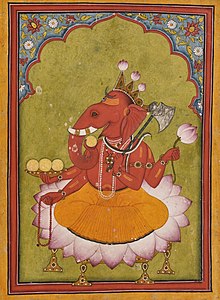Ganesh Festival
Ganesh Festival
Although it was unknown when or where Ganesh Chaturthi was first observed, the public celebration was initiated by Bal Gangadhar Tilak in Pune in the year 1893. At public venues, along with the reading of texts and group feasting, athletic and martial arts competitions are also held.I followed with the greatest curiosity crowds who carried in procession an infinite number of idols of the God Ganesh. Each little quarter of the town, each family with its adherents, each little street corner I may almost say, organizes a procession of its own, and the poorest may be seen carrying on a simple plank their little idol or of paper mâché... A crowd, more or less numerous, accompanies the idol, clapping hands and raises cries of joy, while a little orchestra generally precedes the idol.
– Angelo de Gubernatis, Bombay GazetteHistory
Ganesha
Though not alluding to the classical form of Ganapati, the earliest mention of Ganapati is found in the Rigveda. It appears twice in the Rigveda, once in shloka 2.23.1, as well as in shloka 10.112.9.[15][16][17] Both of these shlokas imply a role of Ganapati as "the seer among the seers, abounding beyond measure in food presiding among the elders and being the lord of an invocation", while the shloka in mandala 10 states that without Ganapati "nothing nearby or afar is performed without you", according to Michael.[15][18] However, it is uncertain that the Vedic term Ganapati which literally means "guardian of the multitudes", referred specifically to later era Ganesh, nor do the Vedic texts mention Ganesh Chaturthi.[19] appears in post-Vedic texts such as the Grhya Sutras and thereafter ancient Sanskrit texts such as the Vajasaneyi Samhita, the Yajnavalkya Smriti and the Mahabharata mention Ganapati as Ganesvaras and Vinayak. Ganesh appears in the medieval Puranas in the form of "god of success, obstacle remover". The Skanda Purana, Narada Purana and the Brahma Vaivarta Purana, in particular, profusely praise him. [20] Beyond textual interpretations, archaeological and epigraphical evidence suggest Ganesha had become popular, was revered before the 8th century CE and numerous images of him are traceable to the 7th century or earlier.
For example, carvings at Hindu, Buddhist, and Jain temples such as at the Ellora Caves, dated between the 5th and 8th-century show Ganesha reverentially seated with major Hindu goddess (Shakti).[21]
Festival
Although it is unknown when (or how) Ganesh Chaturthi was first observed,[22] the festival has been publicly celebrated in Pune since the era of King Shivaji (1630–1680, founder of the Maratha Empire).[22] The Peshwa in the 18th century were devotees of Ganesha and started as a public Ganesh festival in their capital city of Pune during the month of Bhadrapad.After the start of the British Raj, the Ganesh festival lost state patronage and became a private family celebration in Maharashtra until its revival by Indian freedom fighter and social reformer Lokmanya Tilak.Indian freedom fighter Lokmanya Tilak,championed it as a means to circumvent the colonial British government ban on Hindu gatherings through its anti-public assembly legislation in 1892.
According to others such as Kaur, the festival became a public event later, in 1892 when Bhausaheb Laxman Javale (also known as Bhau Rangari), installed the first sarvajanik (public) Ganesha idol in Pune.[31] In 1893, the Indian freedom fighter Lokmanya Tilak praised the celebration of Sarvajanik Ganesh Utsav in his newspaper, Kesari, and dedicated his efforts to launch the annual domestic festival into a large, well-organised public event.[32] Tilak recognised Ganesh's appeal as "the god for everybody",[33] and according to Robert Brown, he chose Ganesha as the god that bridged "the gap between Brahmins and non-Brahmins", thereby building a grassroots unity across them to oppose British colonial rule.
Other scholars state that the British Empire, after 1870 out of fear of seditious assemblies, had passed a series of ordinances that banned public assembly for social and political purposes of more than 20 people in British India, but exempted religious assembly for Friday mosque prayers under pressure from the Indian Muslim community. Tilak believed that this effectively blocked the public assembly of Hindus whose religion did not mandate daily prayers or weekly gatherings, and he leveraged this religious exemption to make Ganesh Chaturthi to circumvent the British colonial law on large public assembly. He was the first to install large public images of Ganesha in pavilions in Bombay Presidency, and other celebratory events at the festival.
—Lokmanya Tilak, Kesari, 8 September 1896[36]
According to Richard Cashman, Tilak recruited and passionately committed himself to god Ganesha after the 1893 Hindu-Muslim communal violence in Bombay and the Deccan riots, when he felt that the British India government under Lord Harris had repeatedly taken sides and not treated Hindus fairly because Hindus were not well organised. In Tilak's estimate, Ganesha worship and processions were already popular in rural and urban Hindu populations, across social castes and classes in Baroda, Gwalior, Pune and most of the Maratha region in the 18th century. In 1893, Tilak helped expand Ganesh Chaturthi festival into a mass community event and a hidden means for political activism, intellectual discourse, poetry recitals, plays, concerts, and folk dances.
In Goa, Ganesh Chaturthi predates the Kadamba era. The Goa Inquisition had banned Hindu festivals, and Hindus who did not convert to Christianity were severely restricted. However, Hindu Goans continued to practice their religion despite the restrictions. Many families worship Ganesha in the form of patri (leaves used for worshiping Ganesha or other gods), a picture is drawn on paper or small silver idols. In some households Ganesha idols are hidden, a feature unique to Ganesh Chaturthi in Goa due to a ban on clay Ganesha idols and festivals by the Jesuits as part of the Inquisition.
External link
- Media related to Ganesh Chaturthi at Wikimedia Commons
- https://en.wikipedia.org/wiki/Ganesh_Chaturthi
:max_bytes(150000):strip_icc():format(webp)/GettyImages-535155562-5931223e3df78c08aba1a24c.jpg)


:max_bytes(150000):strip_icc()/GettyImages-838342254-5b52e61146e0fb00372b06a6.jpg)
Comments
Post a Comment